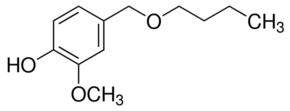Vanillyl butyl ether CAS#: 82654-98-6; ChemWhat Code: 1193681
Identification
| Product Name | Vanillyl butyl ether |
| IUPAC Name | 4-(butoxymethyl)-2-methoxyphenol |
| Molecular Structure |  |
| CAS Registry Number | 82654-98-6 |
| FEMA Number | 3796 |
| EINECS Number | No data available |
| MDL Number | MFCD00238529 |
| Beilstein Registry Number | No data available |
| Synonyms | 4-(butoxymethyl)-2-methoxyphenol, butyl vanillyl ether, vanillyl butyl ether, vanillyl alcohol n-butyl ether CAS Number: 82654-98-6 CAS No.: 82654-98-6 CAS: 82654-98-6 |
| Molecular Formula | C12H18O3 |
| Molecular Weight | 210.270 |
| InChI | InChI=1S/C12H18O3/c1-3-4-7-15-9-10-5-6-11(13)12(8-10)14-2/h5-6,8,13H,3-4,7,9H2,1-2H3 |
| InChI Key | VLDFMKOUUQYFGF-UHFFFAOYSA-N |
| Canonical SMILES | CCCCOCc1ccc(c(c1)OC)O |
| Patent Information | ||
| Patent ID | Title | Publication Date |
| US2019/269626 | Hair Protection Effect of Vanillyl Alkyl Ether and the Application thereof | 2019 |
| US2007/36733 | Sensation masking composition | 2007 |
| US2006/269500 | Topical warming composition | 2006 |
Physical Data
| Appearance | Colorless to Pale Yellow liquid |
| Solubility | It is soluble (Insoluble in water. Soluble in organic solvents, oils.) |
| Flash Point | >230 °F |
| Refractive index | n20/D 1.511~1.521 |
| Density | 1.048~1.068 |
| Sensitivity | No data available |
| Boiling Point, °C |
| 165 |
| 240 – 241 |
Spectra
| Description (NMR Spectroscopy) | Nucleus (NMR Spectroscopy) | Solvents (NMR Spectroscopy) | Frequency (NMR Spectroscopy), MHz |
| Chemical shifts | 1H | chloroform-d1 | 400 |
| Chemical shifts | 1H | CDCl3 | 300 |
| Chemical shifts | 13C | CDCl3 | 75 |
| Description (IR Spectroscopy) | Solvent (IR Spectroscopy) | Temperature (IR Spectroscopy), °C |
| Bands |
| Description (Mass Spectrometry) |
| spectrum |
Route of Synthesis (ROS)
| Conditions | Yield |
| With hydrogen at 20℃; under 7500.75 Torr; for 18h; Industrial scale; Experimental Procedure 1 kg of vanillin, 13.1 liters of n-butanol (vanillin concentration of 0.5 mol / L), 0.2 kg of catalyst A and 0. 05 kg of catalyst E were added to the reactor and charged with IMPa hydrogen, Heated to 20 ° C reaction 18h, the detection of vanillin reaction is complete, stop heating, until the reaction tank after cooling the catalyst, the catalyst directly dry and then use. The filtrate was subjected to rotary evaporation to excess excess butanol, To give vanillin butyl ether 1. 33 kg, yield 96%, purity> 98%. | 96% |
| Stage #1: vanillin; butan-1-ol With Pb/C; hydrogen at 60 – 70℃; under 13501.4 Torr; for 8h; Stage #2: With aluminum (III) chloride at 60 – 70℃; for 12h; Experimental Procedure 2 Comparative Example 2: Preparation of vanillyl butyl ether 100.00 g of vanillin was dissolved in 243.59 g of n-butanol,Stirring and stirring, the metal catalyst Pb-C 2.97g was charged.Filled with 1.8MPa hydrogen, heated to 60 ~ 70 ° C reaction for 8 hours,The vanillin reaction is completely detected, the heating is stopped, and after the reaction liquid is cooled, the metal catalyst Pb-C is recovered by filtration, and the filtrate is put into the reaction tank.14.87 g of aluminum trichloride was added, and the temperature was raised to 60 to 70 ° C for 12 hours.After cooling to room temperature, the solid in the reaction liquid was removed by filtration, the residue was washed, and the washing liquid was combined with the filtrate, and the mixture was distilled under reduced pressure to obtain a crude colorless liquid.After washing with 100 g of water, the organic phase was separated and vacuum distilled at 165 ° C.94.74 g of vanillyl butyl ether was obtained in a yield of 68.55% and a purity of >98%. | 68.55% |
Safety and Hazards
| Pictogram(s) |  |
| Signal | Warning |
| GHS Hazard Statements | H315 (28.57%): Causes skin irritation [Warning Skin corrosion/irritation] H317 (100%): May cause an allergic skin reaction [Warning Sensitization, Skin] H319 (71.43%): Causes serious eye irritation [Warning Serious eye damage/eye irritation] H412 (14.29%): Harmful to aquatic life with long lasting effects [Hazardous to the aquatic environment, long-term hazard] Information may vary between notifications depending on impurities, additives, and other factors. |
| Precautionary Statement Codes | P261, P264, P272, P273, P280, P302+P352, P305+P351+P338, P321, P332+P313, P333+P313, P337+P313, P362, P363, and P501 (The corresponding statement to each P-code can be found at the GHS Classification page.) |
Other Data
| Transportation | NONH for all modes of transport |
| Under the room temperature and away from light | |
| HS Code | No data available |
| Storage | Under the room temperature and away from light |
| Shelf Life | No data available |
| Market Price | USD |
| Use Pattern |
| Pharmaceuticals |
| warming sensate in oral care composition in combination with metal composition and TRPA1 agonist |
| Veterinary |
| a dietary composition for preventing or treating idiopathic vomiting in a companion animal |
| Sensory stimulation agent |
| warming and pungent substance |
| Marker for indication of prescribed drug presence in a patient |
| warming agent for oral, controlled-release warming composition for imparting warming sensation in the mouth and upper portion of the gastrointestinal tract |
| controlling weight |
| reduce the appetite of the consumer |
| Component of confectionary product |
Buy Reagent | |
| No reagent supplier? | Send quick inquiry to ChemWhat |
| Want to be listed here as a reagent supplier? (Paid service) | Click here to contact ChemWhat |
Approved Manufacturers | |
| Warshel Chemical Ltd | http://www.warshel.com/ |
| Want to be listed as an approved manufacturer (Requires approvement)? | Please download and fill out this form and send back to approved-manufacturers@chemwhat.com |
Contact Us for Other Help | |
| Contact us for other information or services | Click here to contact ChemWhat |

